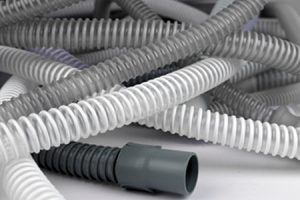
When using a CPAP machine, some people experience nasal congestion, dry nasal passages, sore throats, and nosebleeds and get relief from using heated humidification, which can reduce dryness and improve compliance.
Knowing what CPAP rainout is and how to minimize it can help make sleeping with sleep apnea more restful, especially when you no longer wake up with a damp face. Though moisture in your CPAP equipment can be frustrating to deal with, there are products you can try and changes you can make to help prevent this issue. If you’re waking up and your CPAP mask has water in it, keep reading for lots of helpful tips to prevent condensation in CPAP mask!
What is Rainout and What Causes It?
CPAP rainout happens when humidity reaches an unheated tube and the difference in temperature creates condensation. Then, small droplets of water form and splash against your face causing you to wake up. Picture what happens to an old window in a warm room on a cold day or a chilled can of pop out in the sun on a hot day—similarly, tiny beads of water build up in your CPAP tubing and trickle down the hose to your face.
Rainout is essentially caused by heated air cooling inside your CPAP hose. The warmer the humidifier air or the colder your bedroom, the more condensation is likely to occur. If you have the humidifier set to the highest setting, CPAP rainout is almost guaranteed. Luckily, there are several things you can do to avoid or minimize CPAP rainout.
How Do I Avoid Water in CPAP Hose and Mask?
The best way to avoid water in your CPAP hose and mask is by trying to closely match the temperature inside and outside of your tubing, but sometimes that isn’t enough to prevent CPAP rainout. You may have to incorporate a hose cover or adjust your CPAP humidifier settings to prevent water from collecting in CPAP hose.
Solutions for Rainout
Sleep disruptions from CPAP tubing gurgling or CPAP machine rainout can cause you to feel tired the next day, even if you were in bed for a full eight hours. With sleep apnea, it’s important to set yourself up to get the best sleep possible—and that includes preventing rainout.
Here are six impactful things you can try for a more peaceful night:
Use Heated CPAP Tubing
Made to manage humidification in real-time based on the ambient temperature levels of your bedroom, heated tubing helps reduce CPAP rainout by keeping the temperature of the air consistent as it travels from the humidifier to your mask.
Many popular CPAP manufacturers offer heated tubing options for their equipment, like the ClimateLineAir Heated Tube for the AirSense 10 and AirCurve 10 machines and the Heated Tube for any DreamStation machine. One of the best CPAP hose options available is the non-condensing ClimateLineAir, as it helps prevent rainout and permits movement while you snooze.
Wrap Your Hose to Keep Air Warm
Additionally, wrapping your CPAP hose with a specially-designed tube cover helps insulate the hose and blocks the ambient temperature of your bedroom from causing CPAP rainout. As an added bonus, you can run the tubing underneath your bed covers to provide additional warmth for the hose. Ultimately, having the right CPAP hose accessories go a long way in preventing CPAP rainout and helping you stay asleep.
Adjust the Ambient Temperature
As mentioned, the difference between the temperature of the air in your tubing and the temperature of your bedroom is what creates CPAP rainout. If you keep your room extra cold at night, you’re more likely to experience condensation in your tubing. This is a quick and simple fix, but many people enjoy sleeping in cooler rooms so you may want to adjust the humidifier settings instead.
Adjust Humidifier Settings
The right CPAP humidifier settings can make all the difference. In general, the best humidity level for CPAP machines is a setting of three. To help address CPAP rainout issues, you can adjust the settings by 0.5 increments, but visit with your doctor first. Before changing your humidifier settings, talk to your equipment provider to help discover your best temperature setting for CPAP therapy.
Look for Machines with Automated Adjustments
Most insurance companies will replace your CPAP mask after 90 days and your CPAP machine every five years. A lot can change in five years, including technology upgrades and smart functionality that make your sleep apnea journey more comfortable.
The S9 and Air Solutions CPAP machines from ResMed, for example, feature automated adjustments designed to maintain humidity levels. This special climate control feature constantly monitors the temperature of the air in your mask and how it is affected by ambient temperature. As needed, it simultaneously adjusts the humidifier and tubing levels, providing an optimal temperature that helps prevent CPAP rainout.
Move Your CPAP Machine
Make gravity work for you! Place your CPAP machine at a lower level than your mask so condensation can’t flow to your mask while you sleep. If your CPAP equipment is currently on your nightstand, try moving it to a lower shelf—or even the floor. Any water droplets that do form will flow back into the humidifier instead of sprinkling across your face.
Final Thoughts
Even when treated with the proper CPAP equipment, having sleep apnea can make it challenging to get quality sleep each night. Some experience bloating and some experience skin irritation, but it’s important to maintain compliance since untreated sleep apnea can lead to serious complications. If you’re still facing issues with your mask, machine, or humidifier, it may be beneficial to check out our CPAP solutions resource.
Overall, many people with sleep apnea believe the benefits of using moisture in conjunction with their CPAP equipment outweigh the potential for CPAP rainout, especially since there are steps you can take to mitigate middle-of-the-night disruptions.




